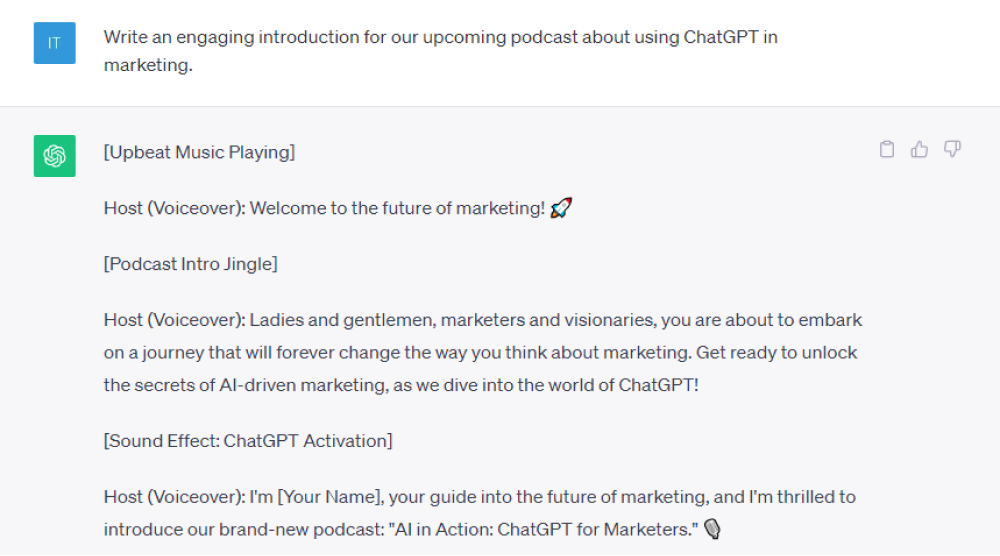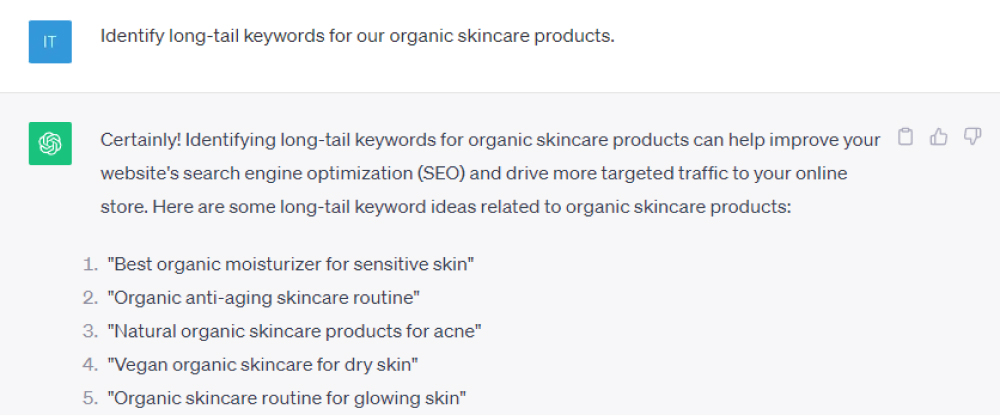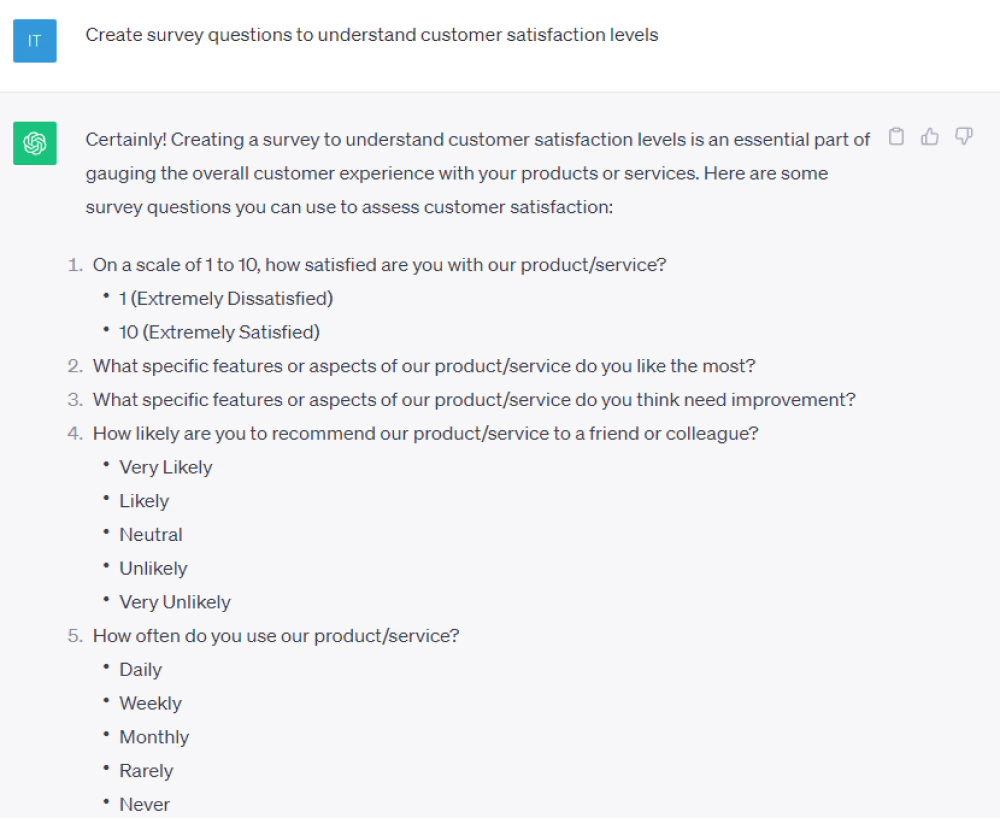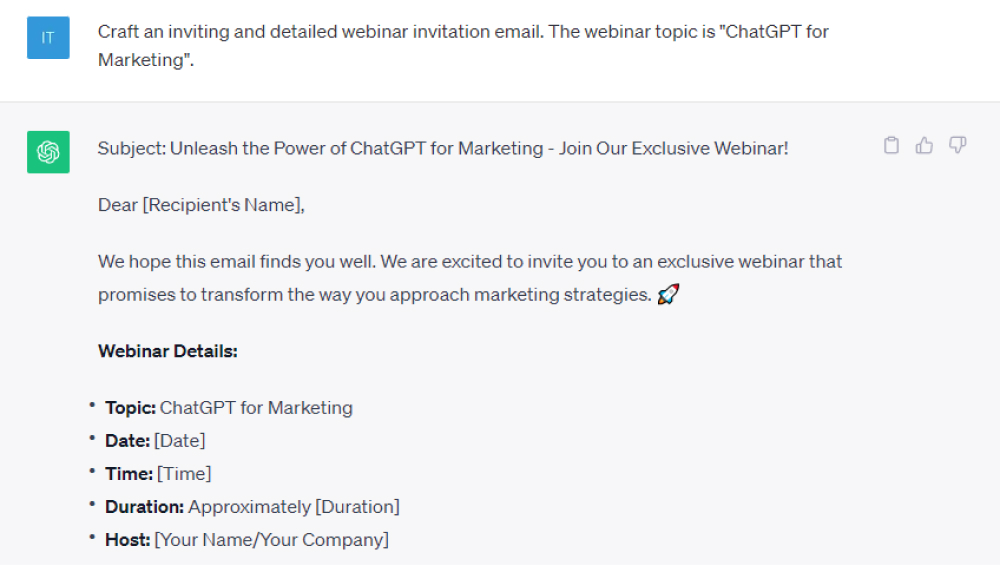
ChatGPT for Marketing
In a world where technology and consumer behaviors continuously evolve, marketers relentlessly search for innovative strategies to stay ahead in the competition. One of the newest arsenals in digital marketing is ChatGPT, a conversational AI model by OpenAI. ChatGPT, with its advanced natural language processing capabilities, is becoming an indispensable tool for marketers aiming to optimize their strategies, increase engagement, and enhance customer experiences. Below are some intriguing ways to utilize ChatGPT in the marketing landscape.
What Is ChatGPT?
ChatGPT is a powerful language model developed by OpenAI, built on the GPT (“Generative Pre-trained Transformer”) architecture. It’s a cutting-edge conversational AI that has been pre-trained on a diverse range of internet text. However, it should be noted that while ChatGPT is highly knowledgeable, it doesn’t understand information or have beliefs and opinions; it generates responses based on patterns and information it learned during its training.
ChatGPT has been trained through a two-step process, including pretraining and fine-tuning. The model is initially pretrained on a large corpus of publicly available text from the internet. This pretrained model, a “creative text generator,” is fine-tuned using custom datasets created by OpenAI, which includes demonstrations of correct behavior and comparisons to rank different responses. Some of the prompts used in fine-tuning come from users of the Playground and the ChatGPT app, with personally identifiable information carefully removed.
How Does ChatGPT Work?
1. Input Processing:
When a user inputs a query or prompt, ChatGPT processes this input text by understanding the context and the information required to generate a suitable response.
2. Contextual Understanding:
ChatGPT is exceptionally skilled at understanding and analyzing the context behind the input. It doesn’t just focus on the immediate question or statement; it considers the overall context to make the conversation flow naturally.
3. Generating Responses:
Based on the input, ChatGPT generates a response. It doesn’t retrieve pre-made answers but creates responses dynamically, ensuring that the answers are relevant to the query while maintaining a conversational flow.
4. Adaptability:
ChatGPT can adapt to a variety of prompts, questions, or conversation styles. It can engage in casual conversation, answer factual questions, help with problem-solving, and more. It adjusts its responses based on the user’s input style and requirements.
5. Continuous Learning:
While ChatGPT does not learn in real-time from individual user interactions, the model is continuously improved through periodic updates, where new data might be incorporated to make the model more accurate, knowledgeable, and reliable.
The features of ChatGPT make it a highly powerful and versatile conversational agent, capable of driving innovation and efficiency across multiple domains. Its natural language understanding, dynamic response generation, and broad knowledge base are just a few features that stand out, making it an invaluable asset for enhancing communication, information dissemination, and user engagement.
How to Use ChatGPT for Marketing
1. Customer Service and Support
ChatGPT can revolutionize customer service and support by providing real-time, 24/7 assistance, managing a wide array of customer inquiries, issues, and complaints. It ensures customers always have immediate access to help, which can lead to improved customer satisfaction and loyalty. Implementing ChatGPT can also reduce the workload on human agents, allowing them to focus on more complex customer queries. This fusion of human and AI capabilities ensures a more comprehensive and efficient customer support system.
Examples of Useful Prompts:
- “Help me find information on product warranties.”
- “Assist me in troubleshooting a problem with my device.”
2. Content Creation
ChatGPT can be a valuable ally in content creation, helping marketers produce various content types like blog posts, product descriptions, and social media posts. Its advanced language model ensures the content is engaging, accurate, and human-like. It can adapt to different writing styles and tones, ensuring consistency and alignment with brand identity, facilitating the creation of content that resonates with the target audience and serves the strategic objectives effectively.
Examples of Useful Prompts:
- “Craft a detailed guide on using our new software.”
- “Write an engaging introduction for our upcoming podcast.”

3. Product Recommendations
Utilizing ChatGPT for product recommendations can enhance personalized marketing efforts. It can analyze user needs or previous interactions to provide relevant and thoughtful product or service recommendations. Such personalization can lead to improved user experiences and increased conversion rates, as customers feel more understood and valued by the brand.
Examples of Useful Prompts:
- “Based on my previous purchases, what other products could suit my needs?”
- “Find me a product that fits my budget and preferences.”
4. Email Campaigns and Newsletters
ChatGPT can craft and optimize email content to resonate with recipients better, encouraging them to engage with the brand and take specific actions like making purchases or visiting websites. This includes creating catchy subject lines, compelling calls-to-action, and personalized content that speaks directly to the recipients, enhancing the effectiveness of email marketing campaigns and newsletters.
Examples of Useful Prompts:
- “Design an engaging welcome email for new subscribers.”
- “Create a catchy subject line for our holiday promotions.”
5. Social Media Management
ChatGPT can be used to manage various social media marketing aspects, from creating engaging content to automated response management. It can craft posts, replies, and comments that align with the brand’s voice and engage the audience on different social media platforms. This allows for a more dynamic and responsive social media presence, improving the brand’s online visibility and engagement.
Examples of Useful Prompts:
- “Draft a series of tweets highlighting our upcoming promotions.”
- “Generate responses to common comments on our Instagram posts.”
6. SEO and Keyword Optimization
ChatGPT can optimize content for SEO by incorporating relevant keywords and phrases strategically. This enhances the visibility of websites, blog posts, and product pages in search engine results, driving organic traffic and improving overall online presence. It can also assist in keyword research, identifying terms that potential customers are likely to use in their searches.
Examples of Useful Prompts:
- “Identify long-tail keywords for our organic skincare products.”
- “Optimize this article to rank for ‘sustainable fashion tips.’”

7. Survey and Feedback Collection
ChatGPT can design detailed and engaging surveys or feedback forms to garner valuable customer insights. Its conversational abilities can make these instruments more interactive and user-friendly, encouraging participation and ensuring more accurate and helpful feedback, aiding in improving products or services based on customer preferences and expectations.
Examples of Useful Prompts:
- “Create survey questions to understand customer satisfaction levels.”
- “Design a feedback form to gather opinions on our new website design.”

8. Personalized User Experience
Implementing ChatGPT in user experience design can result in more personalized and engaging user interactions on websites or apps. From greeting users by name to tailoring content based on user preferences and behavior, ChatGPT can enhance user satisfaction, promoting return visits and loyalty.
Examples of Useful Prompts:
- “Develop personalized content suggestions for different user profiles.”
- “Create dynamic landing pages based on user behavior and preferences.”
9. Interactive and Engaging Advertisements
ChatGPT’s creative capabilities can be harnessed to develop advertisements that captivate audiences through storytelling and interactive elements. It can help design ads that resonate with viewers emotionally and intellectually, encouraging engagement and improving the overall effectiveness of advertising campaigns.
Examples of Useful Prompts:
- “Develop a storyline for our brand’s video advertisement.”
- “Create engaging and concise ad copy for various platforms.”
10. Event Promotion
ChatGPT can be instrumental in promoting events, webinars, or product launches, crafting engaging and informative communications. From announcements and invitations to follow-up messages, each communication can be optimized to encourage participation, engagement, and the building of lasting relationships with attendees.
Examples of Useful Prompts:
- “Craft an inviting and detailed webinar invitation email.”
- “Create engaging social media posts to promote our upcoming event.”

Pros and Cons of Using ChatGPT for Marketing
Pros
- Cost-Efficiency
Automated Customer Interactions: ChatGPT can handle a multitude of customer queries without human intervention, reducing the operational costs associated with customer service.
- 24/7 Availability
Always-On Service: ChatGPT operates around the clock, ensuring that customers from different time zones always have access to immediate support or information.
- Personalization
Tailored Customer Experiences: It can personalize interactions, recommendations, and content based on user preferences and behaviors, enhancing the customer experience.
- Scalability
Handling Volume: ChatGPT can interact with a vast number of users simultaneously, allowing businesses to scale their customer support and engagement efforts without a proportional increase in costs.
- Versatility
Multifunctional: It can be used in various aspects of marketing, from content creation and email campaigns to social media management and SEO.
- Consistent Brand Messaging
Maintaining Tone: ChatGPT can maintain a consistent tone and messaging style, ensuring that customer interactions align with the brand’s identity.
- Quick Implementation
Easy Setup: Implementing ChatGPT into marketing strategies is relatively straightforward, allowing businesses to quickly enhance their marketing efforts.
Cons
- Limited Understanding
Lack of Nuance: While powerful, ChatGPT might not fully grasp or convey the nuances of some queries or responses, leading to potential misunderstandings.
- Dependency on Training Data
Bias and Accuracy: ChatGPT’s responses are influenced by its training data, which may sometimes lead to biased or less accurate information being shared.
- Lack of Emotional Intelligence
Missed Human Touch: Despite being conversational, ChatGPT cannot truly empathize with users or understand the emotional undertones in interactions, which might be crucial in some customer engagements.
- Quality Control
Unpredictable Responses: Without careful oversight and continuous improvement, there’s a possibility of ChatGPT generating inappropriate or off-brand responses.
- Technical Dependencies
Reliance on Technology: A business becomes technologically dependent, requiring continuous updates, monitoring, and potential troubleshooting.
- Data Security
Handling Sensitive Information: Ensuring that interactions managed by ChatGPT are secure and that customer data is handled appropriately is crucial.
- Customization Limitations
Generic Responses: Customizing ChatGPT to meet specific brand needs or to operate within a particular industry niche might not always yield highly specialized or nuanced responses.
Tips For Using ChatgGPT
Utilizing ChatGPT to its fullest potential requires a mix of strategic planning, careful implementation, and continuous improvement. Here are some practical tips for using ChatGPT effectively:
1. Define Clear Objectives
- Purpose Identification: Clearly define what you want to achieve with ChatGPT, whether it’s customer support, content creation, or data analysis.
- Goal Setting: Set specific, measurable goals to assess the performance and impact of ChatGPT in your operations.
2. Customization and Personalization
- Tailoring Conversations: Customize the responses and conversation style of ChatGPT to align with your brand voice and audience preferences.
- User-Centric Approach: Personalize interactions to enhance user experience, making conversations more engaging and relevant.
3. Continuous Monitoring and Improvement
- Quality Assurance: Regularly monitor and assess the quality and relevance of ChatGPT’s responses to ensure they meet your standards and objectives.
- Feedback Loop: Establish a feedback loop to continuously improve and adapt the model’s performance based on user interactions and feedback.
4. Utilize the API for Integration
- Application Integration: Make use of OpenAI’s API to integrate ChatGPT seamlessly into your applications, websites, or platforms.
- API Customization: Utilize the flexibility of the API to customize the integration of ChatGPT according to your specific needs and objectives.
5. Ensure Data Security and Privacy
- Sensitive Data Handling: Ensure that the utilization of ChatGPT complies with data security and privacy regulations.
- Secure Interactions: Implement security measures to protect the integrity and confidentiality of user interactions with ChatGPT.
6. Leverage Multifunctional Capabilities
- Diverse Applications: Explore the various capabilities of ChatGPT, such as language translation, summarization, and question-answering to maximize its utility.
- Cross-Functional Use: Don’t limit ChatGPT to a single function; leverage its multifunctional capabilities across different areas of your operations.
7. Manage User Expectations
- Clarify Limitations: Make users aware of what ChatGPT can and cannot do, managing expectations effectively.
- Guided Interaction: Provide guidance to users on how to interact effectively with ChatGPT to get the best results and experiences.
8. Engage in Regular Testing and Evaluation
- Performance Assessment: Conduct regular tests to evaluate ChatGPT’s performance, relevance, and accuracy in responses.
- Adaptation to Changes: Ensure that ChatGPT remains up-to-date and adaptable to changes, trends, and evolving user needs.
9. Utilize Educational and Support Resources
- Learning and Development: Utilize available resources, guides, and documentation to enhance your understanding and utilization of ChatGPT.
- Community Engagement: Engage with communities and forums to gain insights, tips, and support for optimizing your use of ChatGPT.
Successfully utilizing ChatGPT involves strategic planning, customization, and continuous improvement. By following these tips, you can optimize the performance of ChatGPT, ensuring that it effectively meets your objectives, aligns with user needs, and delivers high-quality, engaging interactions. Remember that ChatGPT is a powerful tool, and with careful management and strategic implementation, it can be a tremendous asset in achieving your operational and business goals.
Conclusion
In digital marketing, ChatGPT is a revolutionary asset that redefines customer interactions, content creation, and overall marketing strategies. Its multifaceted capabilities, ranging from automating customer engagements to generating creative content, unlock unparalleled opportunities for marketers to innovate and enhance their outreach efforts.
However, the success of integrating ChatGPT into marketing practices hinges on a nuanced understanding of its functionalities, strengths, and limitations. Marketers must strategically align ChatGPT’s capabilities with their organizational objectives, ensuring that it serves as a complement to human intelligence and creativity. Continuous monitoring, customization, and improvement are key to leveraging ChatGPT’s full potential, ensuring that it remains a relevant, efficient, and impactful tool in a brand’s marketing arsenal.
Embracing ChatGPT in marketing is not merely about adopting a technological advancement but involves cultivating a tool that dynamically adapts, learns, and improves. It’s about fostering a seamless synergy between technology and marketing goals to craft engaging, personalized, and meaningful customer experiences. As we navigate the future of marketing, ChatGPT stands as a beacon of innovation, poised to transform digital marketing landscapes with its unparalleled conversational intelligence and creative prowess.
FAQ
Q1: What is ChatGPT, and how is it relevant to marketing?
A1: ChatGPT is a powerful language model developed by OpenAI. It excels at natural language understanding and generation, making it highly relevant for various marketing applications such as content creation, customer service automation, and personalized marketing strategies.
Q2: How can ChatGPT be utilized for content creation in marketing?
A2: ChatGPT can be used to generate creative and engaging content such as blog posts, social media updates, and product descriptions. It can help in brainstorming session, generating ideas, and even creating drafts for various content pieces.
Q3: Can ChatGPT handle customer queries and improve customer engagement?
A3: Yes, ChatGPT can be integrated into chatbots or customer service interfaces to handle customer queries, provide product information, and solve common problems, contributing to improved customer engagement and satisfaction.
Q4: Is ChatGPT capable of personalizing marketing messages and interactions?
A4: ChatGPT can analyze and respond to user inputs in a way that feels personalized and engaging. It can tailor messages and recommendations based on user preferences and interaction history.
Q5: What are the challenges or limitations of using ChatGPT in marketing?
A5: While powerful, ChatGPT has its limitations, such as potential biases, limited understanding of nuance, and a dependency on its training data. It requires careful management and monitoring to ensure that its responses align with brand values and customer expectations.
Q6: How can businesses ensure that their use of ChatGPT complies with data privacy regulations?
A6: Businesses should ensure that their implementation of ChatGPT adheres to data protection regulations such as GDPR. It’s essential to secure user data and ensure that interactions with ChatGPT are encrypted and safeguarded against unauthorized access.
Q7: Can ChatGPT be customized to represent a brand’s voice and style?
A7: Yes, ChatGPT’s responses can be customized to align with a brand’s voice, messaging style, and communication guidelines, helping maintain brand consistency across customer interactions.
Q8: How does ChatGPT adapt and improve over time?
A8: ChatGPT doesn’t learn in real-time, but developers can use feedback and interaction data to fine-tune and improve its performance, ensuring that it remains relevant and effective in meeting user needs and expectations.
Q9: Is ChatGPT capable of multilingual interactions?
A9: ChatGPT has multilingual capabilities, allowing it to interact with users in various languages, which can be particularly beneficial for businesses aiming to reach a diverse, global audience.
Q10: Where can businesses seek guidance and support in implementing ChatGPT in their marketing strategies?
A10: Businesses can access documentation, guides, and community forums provided by OpenAI. They can also consider consulting with experts or agencies specializing in AI and marketing technologies for professional guidance and support.

Jeremy Brosius is a Senior Editor for Comeover.io, a leading tech website that focuses on PC hardware and gaming. With a deep passion for technology and an extensive knowledge of the PC hardware scene, Jeremy has become a well-known figure in the industry.
To contact the author, please reach out via email.
